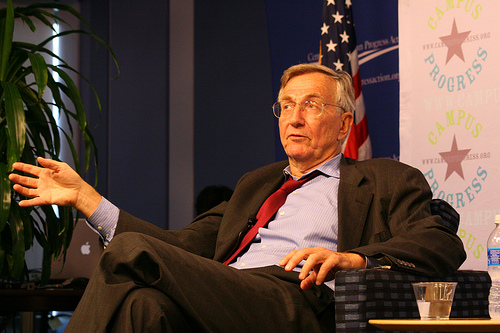El Salvador: The Conference and the Bubble
by Horacio Castellanos Moya and translated by Sam Cogdell / June 20, 2013 / No comments
Why did mainstream Salvadorian media ignore a distinguished journalist conference?

Seymour Hersh, a 'living legend' in American journalism. Photo: Campus Progress via Flickr.
On May 18, an event was held in San Salvador that was rare, if not unheard of, in that part of the world. The unlikely affair featured a public conversation between Seymour Hersh and Jon Lee Anderson, two of the most prestigious reporters in American journalism. Both are living legends. Speaking to an overflow audience that was crammed into one of the galleries at the Museum of Art, Anderson, the disciple, introduced his mentor, Hersh, then posed a series of questions that prompted Hersh to recount his experiences as a reporter. These included uncovering the My Lai massacre, which was perpetrated by the U.S. Army in Vietnam in 1968, and decades later, revealing the existence of jails in Abu Ghraib where the same army inflicted torture on Iraqi prisoners. Hersh impressed the audience with the richness of his storytelling, the clarity with which he described events, his frankness, and especially the transparency of his ethical principles.

- Corkscrew is focused on Latin American issues. Literature, journalism and politics are the main concerns of this column. A corkscrew is useful only if it opens a bottle, hopefully full of something that would enlighten our spirits, but we could also set loose a cruel Genie or a rotten wine. The author will follow this principle: look for topics that open debates, new perspectives, and controversy. Cheers!

- Horacio Castellanos Moya is a writer and a journalist from El Salvador. For two decades he worked as a journalist in Mexico, Guatemala, and his own country. He has published ten novels, five short story collections and two books of essays. He was granted residencies in a program supported by the Frankfurt International Book Fair (2004-2006) and at City of Asylum/Pittsburgh (2006-2008). In 2009, he was a guest researcher at the University of Tokyo. Currently he teaches at the University of Iowa.
Both New Yorker reporters were in San Salvador at the invitation of the weekly news magazine El Faro, which celebrated its fifteenth year of publication with a marathon conference on the challenges facing contemporary journalism, featuring distinguished journalists from all over the world. The list of attendees included two recent Pulitzer Prize winners, editors, columnists, and writers, as well as top-level international experts on covering narcotrafficking, corruption, and human rights. The Hersh-Anderson dialogue was the culminating moment of the conference, the cherry on top, so to speak.
The fact that an event such as this, with the power to draw such a large audience, could have taken place in San Salvador at all speaks to the international importance El Faro has acquired as an online news outlet for its daring investigations and bold reporting on corruption, narcotrafficking, and immigration issues. Upon reading this, one might automatically assume that a gathering of this magnitude evinces a collective, qualitative leap forward for the Salvadoran press over the past few years, but this conclusion isn’t really true.
If, on the week the event took place, you leafed through either of the two leading Salvadoran daily newspapers, or tuned into the newscasts of the main television and radio networks, you wouldn’t find the slightest hint that journalistic figures of this magnitude had taken part in any public events. Put simply, El Faro‘s conference was a non-event for the so-called “mainstream” Salvadoran press. Why? What reasons did the leading media outlets have for ignoring a debate among leading figures in world journalism—a debate that would have made news in any other Latin American city or the United States? Intellectual poverty? Apathy? Or perhaps envy of the international recognition of the work being done by El Faro?
Some conference invitees expressed surprise. I did not. I have said this before. Every time I return to San Salvador and open the newspapers or watch a newscast, I have the feeling that time has stood still, that essentially the same narrow mentality that existed before the civil war still prevails there, and that the country is living inside a bubble. On this occasion, it was just the same, except that when I went to the museum where the conference was being held, it was as if I were entering another country, as if the conference ignored by mass media was, in effect, taking place somewhere else.
Translated by Sam Cogdell




